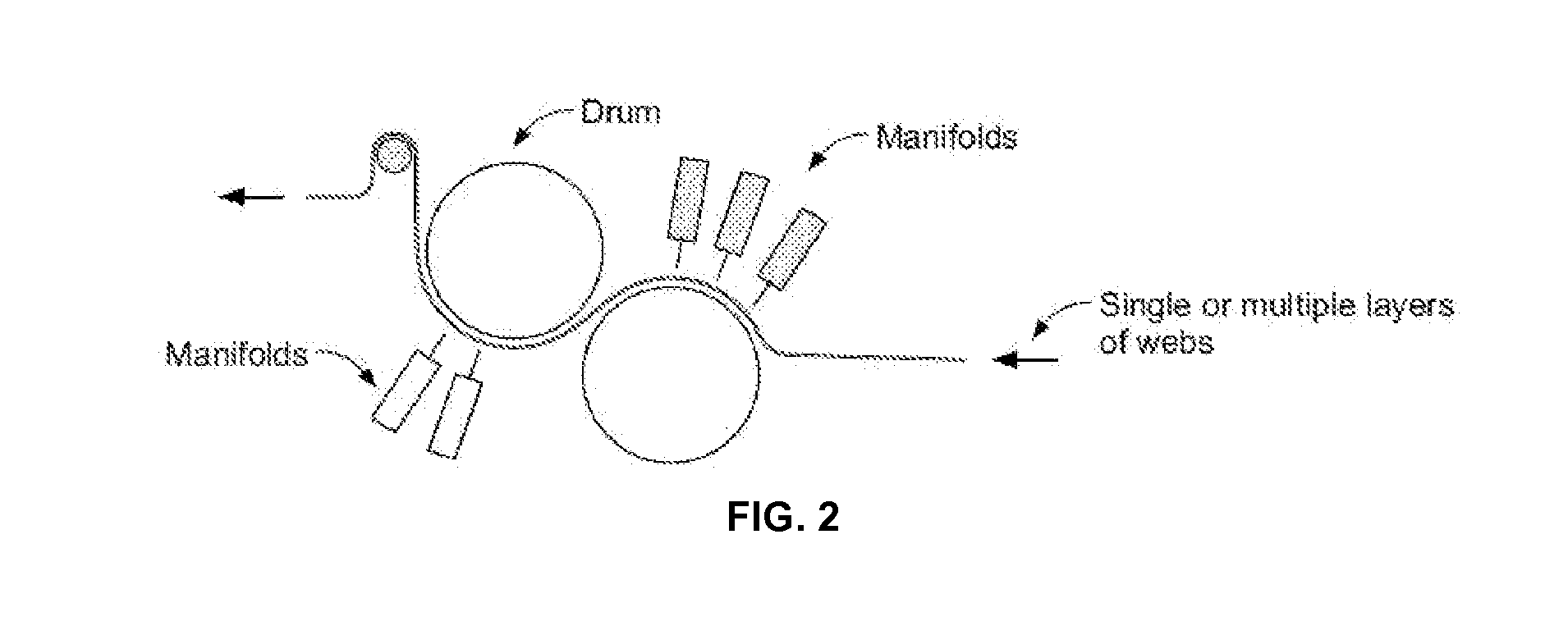Multicomponent fibers and microdenier fabrics prepared by fibrillation thereof
a technology of microdenier fabrics and fibers, which is applied in the direction of needling machines, weaving, transportation and packaging, etc., can solve the problems of poor fabric formation, unfavorable production of nonwoven elastomers where the elastomer is exposed, and remains tacky, so as to reduce the difficulty of spinning
- Summary
- Abstract
- Description
- Claims
- Application Information
AI Technical Summary
Benefits of technology
Problems solved by technology
Method used
Image
Examples
example 1
Elastomeric Example with Permanent Stretch and Recovery
[0069]These samples were made with the cross section in FIG. 7A, where the elastomer (a styrene / isoprene copolymer) was component 24 and components 14 and 22 were selected from nylon 6 for one example and polyester (polyethylene terephthalate with an intrinsic viscosity of 0.56—Eastman Chemical) for the other. The ratios were selected to be 20% by volume elastomer and 80% by volume nylon or polyester. One example was also run with a 50 / 50 ratio for the two polymers.
[0070]Elasticity (stretch and recovery) in the fabrics was achieved by spinning the fibers using the noted cross-section, collecting the fibers on an open mesh belt and using a water jet to break up and entangle the fibers. The method used to prepare the fabrics may affect the openness of the fabric structure. The open structure can be affected by the openness of the collecting belt (e.g. a 14 mesh belt was used for the nylon samples and a 40 mesh was used for the pol...
example 2
Effect of Structure on Unidirectional Stretch and Recovery
[0082]An additional set of fabrics was produced and tested for the effect of structure on unidirectional properties of the fabric with respect to stretch and recovery. The fabrics tested include a 75% PET / 25% elastomer material, a 75% PA6 / 25% elastomer material, and a 50% PA6 / 50% elastomer material. The polymers used in these materials were the same as those used in the previous examples (elastomer=Kraton styrene and isoprene block copolymer, PET=polyethylene terephthalate with an intrinsic viscosity of 0.56 from Eastman Chemical, PA6=polyamide 6 from BASF with a viscosity of 2.7).
[0083]The results of this additional study are summarized below in Table 9. The weights chosen were 100 and 150 g / m2. These were entangled using a 100 mesh stainless steel mesh belt, and some samples were further entangled using an open mesh (14 or 20) polymer belt, as indicated below. The samples were tested according to ASTM test method for Stretc...
PUM
| Property | Measurement | Unit |
|---|---|---|
| weight | aaaaa | aaaaa |
| weight | aaaaa | aaaaa |
| lengths | aaaaa | aaaaa |
Abstract
Description
Claims
Application Information
 Login to View More
Login to View More - R&D
- Intellectual Property
- Life Sciences
- Materials
- Tech Scout
- Unparalleled Data Quality
- Higher Quality Content
- 60% Fewer Hallucinations
Browse by: Latest US Patents, China's latest patents, Technical Efficacy Thesaurus, Application Domain, Technology Topic, Popular Technical Reports.
© 2025 PatSnap. All rights reserved.Legal|Privacy policy|Modern Slavery Act Transparency Statement|Sitemap|About US| Contact US: help@patsnap.com



